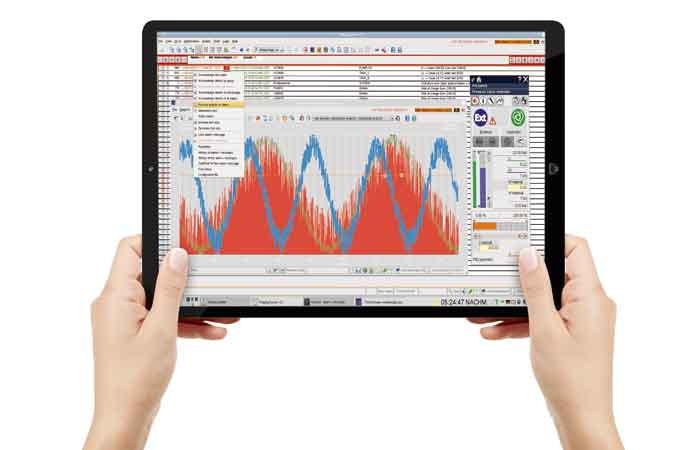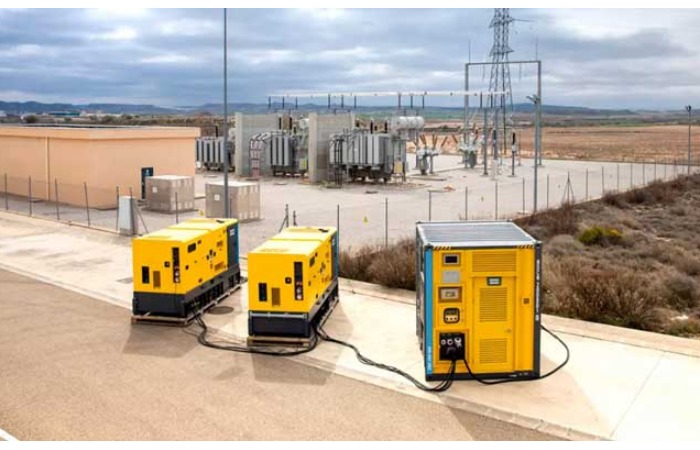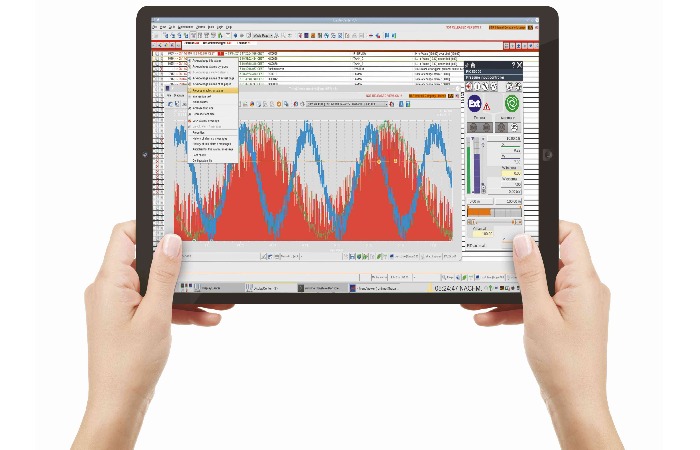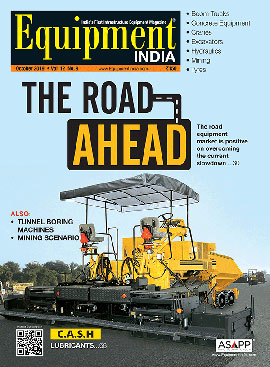Search

What’s Ahead in CE Manufacturing Sector
Construction equipment OEMs are aimed at intensifying products with the latest technologies adding higher productivity, lower maintenance, easy operations, and remote connectivity.

Powering construction sites
The article evaluates the increasing impact of alternative sources of energy on the genset space.

What’s Ahead in CE Manufacturing Sector
The article is authored by Himanshu Sharma, Head – Marketing & Corporate Communication, B&R Industrial Automation.

MTU engine to power KATO excavators
For the first time, Rolls-Royce is supplying MTU-brand engines to Japanese construction machinery manufacturer KATO for use in its excavator segment. The engine ? a 6-cylinder inline Series 1000 unit delivering 210 kW ? will be used to power a 30-tonne hydraulic excavator from KATO?s HD range. Equipped with an SCR system, the MTU engine meets the specifications of Heisei 26 - the emissions stage in effect in Japan since last year.

Sustainable products
SSAB plans to strengthen its position as a leading producer of high-strength steels, while developing the markets in North and Latin America and Asia through advanced offerings based on their cutting-edge expertise. SSAB's advanced high-strength steels provide stronger, lighter, and more durable solutions. This leads to a better total economy, reduced environmental impact and longer product lifespan.

Liebherr is open to feasible customised solutions...
When it comes to equipment selection, fuel and energy efficient parameters are con?si?dered to be the two major parameters that constitute the operating cost of a machine,

GMMCO believes in total product support
There is enormous potential for duty cycle cranes in India, but as of now, the concept has not been popularised in the country, even as demand is climbing,? says M Saravanan, Business Head, New Business, GMMCO. 0 - - 14428 14 102 2011-03-01 00:00:00.000 Equipment India We are in the process of further investment for new product lines
?Sany gives top priority for safety and the cranes designed and produced by us are all incorporated with the safety features which are required globally,? says Rajesh Kawoor, Vice President ? Sales, Sany Heavy Industry India. Excerpts from the interview.
How is Sany placed in a fast-evolving scenario, in the Indian context?
Looking at the emerging scenario in the Indian market, we are experiencing a very positive atmosphere. The growth pattern up to 2008 was very steady and upward but in 2009 and 2010, the growth was erratic and not uniform. As far as Sany India operations are concerned, we are anticipating a growth rate of about 30 per cent and major growth is envisaged in cranes and concrete machinery.
What sort of topline growth is Sany looking at in the next five years?
In the next five years, we are looking at a growth rate with an increase of about 5-10 per cent every year, compared to the preceding year. We are also in the process of deciding on future investment in the coming years and to start production of new product lines.
Brief us about your R&D spend.
The Sany Group spends about 7-9 per cent of sales revenue on R&D and as Sany India R&D is in place, the spending pattern will be similar to Sany Group policy.
What is the market potential for crawler cranes in India?
The potential for crawler cranes in the building segment is for smaller capacities up to 80T and we do not see any drastic change in this segment. We see the largescale projects, power plants and windmills as the largest users of crawler cranes; the requirement from this segment is for higher capacities.We are expecting a steady growth in the next five years and we see the requirements of higher capacity crawler canes will definitely increase.
How do you look at the issues of training/and skilled operators?
On-site and classroom training are conducted for the customers, operators and technical staff to explain the operation procedure and also for regular maintenance procedures. The operators are trained and also tested to check their calibre. If they are found lacking in any aspect, Sany takes special care and initiative for training that operator until he is confident, thus making the crane operation for the customer safe and smooth.
Do all the engines used comply with emission norms?
Sany cranes are mounted with the world?s best known engines, Cummins and Deutz, which are within the environmental norms. For cranes of capacity 50T to 250T, we have the Cummins engine and for higher capacity cranes of 400T and 630T we have the Deutz engine.
Inbuilt safety system
? SLI (Safe Load Indicator): This indicates the percentage of load been lifted by the crane, at a specific configuration and working radius.
? Hook movement limiter: The hook movement limiter stops the hook at a safe distance from the boom tip and thus avoids collision and damage to the boom.
? Angle sensor: The angle sensor is installed on the main boom foot and also at the luffing boom foot, so as to indicate the working angle of the main boom and luffing boom separately.
? Load sensor: This device indicates the amount of load that has been lifted by the crane, the actual load.
? Anemometer: It indicates the wind speed to the operator and he can lower the boom if experiencing turbulent wind flow at the work site.
? Pawl locks for the winches: The pawl lock is provided for both main winch and auxiliary winch so as to stop wrong operations without the lock being released.
? Limit sensor: It is fitted on the frame near to the boom foot.
? Back stopper: It is an additional safety device which stops the boom from moving above 81 degrees.
? Engine parameter display: This is in the operator cabin which provides the customer with all the working data of the engine which indicates oil pressure, temperature, coolant temperature, fuel available in tank, engine RPM, battery voltage, etc,
? Camera and visual display: Two cameras are fitted on the crane which provides the rear view of the crane and also of the winches.
? Swing alarm: The beeper works automatically when the crane swings.
? Future safety installation: Camera on luffing tip.
?The potential from the aftermarket is huge and the competition is intense. We are expanding our distribution network and product portfolio to meet the challenges from the aftermarket,? says Ajith Raj Nair, Joint Managing Director, Mann + Hummel. In an exclusive interview with Equipment India, Ajith Raj talks about the growth prospects of the industrial filter market. Excerpts from the interview.
How is Mann + Hummel placed to meet the surging demands in this evolving scenario?
For Mann+Hummel, the year 2010 was challenging and we are proud to inform that we achieved the highest turnover in our filter business for industrial equipment. We are better placed now, eager and ready to face the challenges of 2011 and the years to come.
How does Mann + Hummel look at ending this fiscal?
Our fiscal year is from January to December and we have achieved a record turnover in 2010, a growth of over 60 per cent compared to last year.
What sort of topline growth are you looking at in the next five years?
We are looking at a CAGR of about 30 per cent for the next five years. We see the growth from garnering more of a market share as the market has appreciated the Mann filter for its quality and consistency.
Taking into account the coming emission norms, how confident are you of meeting such stringent norms?
Mann+Hummel has always been in the forefront for introducing innovative and eco-friendly products that help the OEMs to achieve and conform to the stringent emission norms. Such technologies are mature in Europe and Mann + Hummel is already a leading supplier. This helps us to get a jumpstart for such requirements as and when they are introduced in this country. The focus is not only on the emissions but also on ELV directives. A lot of research is underway to look at alternate materials that can be recycled and reused without harming the ecological balance.
What are Mann + Hummel?s core competencies and strengths?
Started in Germany, Mann+Hummel is a 70-year old company, having presence in over 41 locations globally. Our vision is leadership in filtration with vast knowledge that we have built over the years. We are a preferred OEM supplier and have been a development partner for various filtration solution for our customers.
How do you look at the potential from the aftermarket?
The potential is huge and the competition is intense. We are expanding our distribution network and product portfolio to meet the challenges from the aftermarket. Our own R&D facility in Peenya, Bengaluru, gives us an advantage for high quality product development and product range expansion.
How do you look at competition in this sector?
Competition is intense, especially with respect to price. Fortunately, for the industrial customer, the price that he pays for having used a cheap filter is much more than what he can pay for a higher quality filter. This is also well understood in the market and has been the reason for our success. We are competitively priced.
Can you name some of the OEMs Mann + Hummel supply in India?
We are OEM to all major construction, engine and compressor manufacturers.
Brief us about your R&D spend, and also the latest technological trends in the market.
At the global level, we spend about 4 per cent of our annual turnover on R&D. In India also, we have invested heavily on setting up the state-of-the-art R&D centre in Bengaluru.
How successful has Mann + Hummel been in integrating various functions of filtration into a single module with compact design? What is the response from the user industry?
We have had a very good response from OEMs abroad for such modules as it saves lot of space, money, etc.
What was the response to DPF?
In Europe, the response has been very encouraging; it will catch on in India as well.
What is the potential for water filtration systems? Is Mann + Hummel geared to meet the requirements?
The potential is huge. It is a billion- dollar market and we are gearing up for this challenge. We have recently acquired a membrane manufacturing company, Ultra Flo in Singapore, and this will help us in being competitive and in providing customised solutions. We have also taken up some projects in India and some are in the pipeline.
Tell us about your production facility, capacity, and investment plans.
Currently, we have one production facility in Tumkur near Bengaluru. We have already started constructing our second production facility at Bawal in north India for our automotive requirements. This second plant will be ready by early 2012. With this, we will also have the opportunity to serve our industrial customers in the north better, with better logistics and reach.



 +91-22-24193000
+91-22-24193000 Subscriber@ASAPPinfoGlobal.com
Subscriber@ASAPPinfoGlobal.com